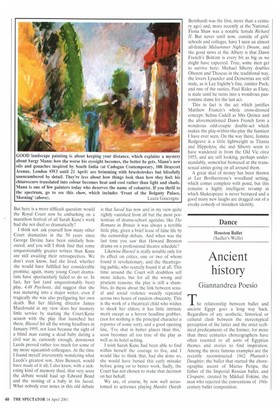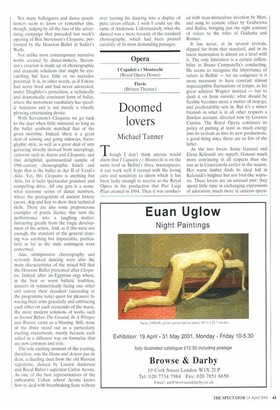Dance
Houston Ballet (Sadler's Wells)
Ancient history
Giannandrea Poe sio
The relationship between ballet and ancient Egypt goes a long way back. Regardless of any aesthetic, historical or cultural clash between the stereotypical perception of the latter and the strict technical predicaments of the former, for more than three centuries choreographers have often resorted to all sorts of Egyptian themes and stories to find inspiration. Among the more famous examples are the recently reconstructed 1862 Pharaoh's Daughter, the ballet that started the choreographic ascent of Marius Petipa, the father of the Imperial Russian ballet, and Cleopatre, created by Mikhail Fokine, the man who rejected the conventions of 19thcentury ballet composition. Not many balletgoers and dance practitioners seem to know or remember this, though, judging by all the fuss of the advertising campaign that preceded last week's opening of Ben Stevenson's Cleopatra, performed by the Houston Ballet at Sadler's Wells.
Not unlike most contemporary narrative works created by dance-makers, Stevenson's creation is made up of choreographic and dramatic solutions that might be eyecatching but have little or no narrative potential. It is, in other words, as if Rikine had never lived and had never advocated, under Diaghilev's protection, a stylistically and dramatically consistent form of ballet, where the movement vocabulary has specific functions and is not merely a visually pleasing entertaining device.
With Stevenson's Cleopatra we go back to the days when little mattered so long as the ballet aesthetic matched that of the given storyline. Indeed, there is a great deal of coming and going sideways, hieroglyphic style, as well as a great deal of arm gesturing directly derived from sarcophagi, cartoons such as Asterix and Cleopatra, and that delightful, quintessential sample of 19th-century choreographic kitsch and hype that is the ballet in Act II of Verdi's Aida. Yet, this Cleopatra is anything but Aida, for it lacks spectacular grandeur and compelling drive. All one gets is a somewhat tiresome series of dance numbers, where the protagonists of ancient history cavort, skip and hop to show their technical skills, There are also some preposterous examples of poetic licence that turn the performance into a laughing matter, detracting greatly from the tragic development of the action, And, as if this were not enough, the standard of the general dancing was anything but impeccable, particularly as far as the male contingent were concerned.
Alas, unimpressive choreography and seriously flawed dancing were also the main characteristics of the mixed bill that the Houston Ballet presented after Cleopatra. Indeed, after an Egyptian orgy where, in the best or worst balletic tradition, dancers sit symmetrically facing one other and convey their decadent (according to the programme note) quest for pleasure by waving their arms gracefully and embracing each other on each crescendo of the music, the more modern solutions of works such as Second Before The Ground, In A Whisper and Bruiser, came as a blessing. Still, none of the three stood out as a particularly exciting masterwork. mainly because each relied in a different way on formulae that arc now common and trite.
The sole exciting moment of the evening, therefore, was the Diana and Acteon pas de deux, a dazzling duet from the old Russian repertoire, danced by Lauren Anderson and Royal Ballet's superstar Carlos Acosta, As one of the best representatives of the unbeatable Cuban school Acosta knows how to deal with breathtaking feats without ever turning his dancing into a display of pure circus effects. I wish I could say the same of Anderson. Unfortunately, what she danced was a mere travesty of the standard choreography, which had been pruned carefully of its most demanding passages.



























































 Previous page
Previous page